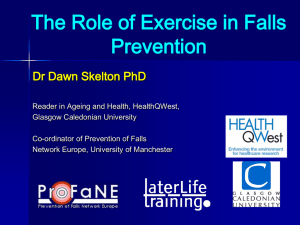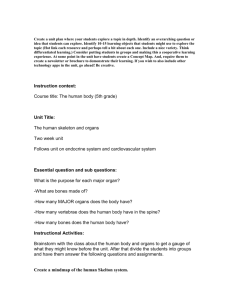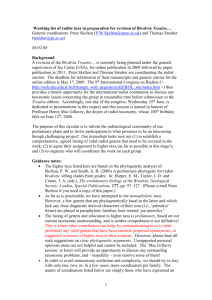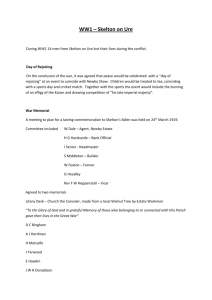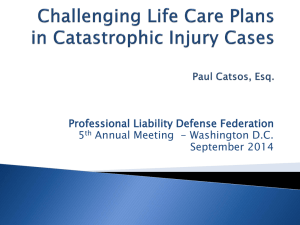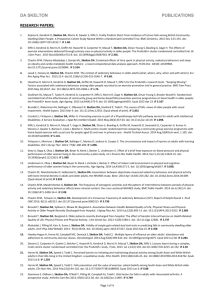facts and procedural history
advertisement
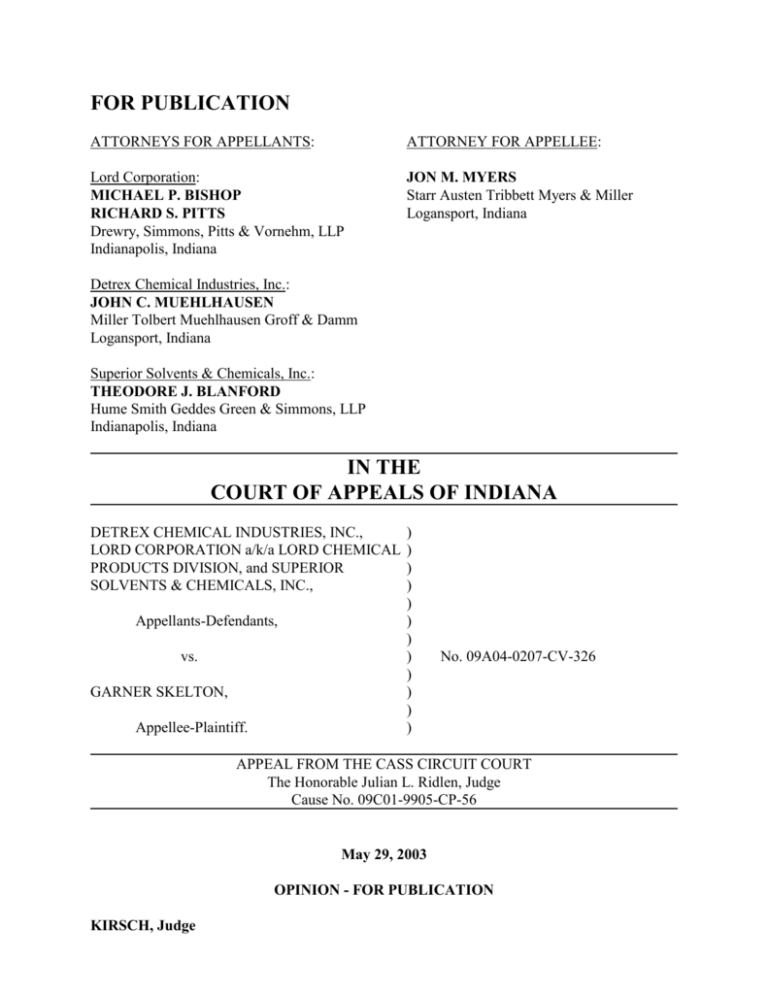
FOR PUBLICATION ATTORNEYS FOR APPELLANTS: ATTORNEY FOR APPELLEE: Lord Corporation: MICHAEL P. BISHOP RICHARD S. PITTS Drewry, Simmons, Pitts & Vornehm, LLP Indianapolis, Indiana JON M. MYERS Starr Austen Tribbett Myers & Miller Logansport, Indiana Detrex Chemical Industries, Inc.: JOHN C. MUEHLHAUSEN Miller Tolbert Muehlhausen Groff & Damm Logansport, Indiana Superior Solvents & Chemicals, Inc.: THEODORE J. BLANFORD Hume Smith Geddes Green & Simmons, LLP Indianapolis, Indiana IN THE COURT OF APPEALS OF INDIANA DETREX CHEMICAL INDUSTRIES, INC., LORD CORPORATION a/k/a LORD CHEMICAL PRODUCTS DIVISION, and SUPERIOR SOLVENTS & CHEMICALS, INC., Appellants-Defendants, vs. GARNER SKELTON, Appellee-Plaintiff. ) ) ) ) ) ) ) ) ) ) ) ) No. 09A04-0207-CV-326 APPEAL FROM THE CASS CIRCUIT COURT The Honorable Julian L. Ridlen, Judge Cause No. 09C01-9905-CP-56 May 29, 2003 OPINION - FOR PUBLICATION KIRSCH, Judge Appellants Detrex Chemical Industries, Inc., Lord Corporation a/k/a Lord Chemical Products Division, and Superior Solvents & Chemicals, Inc. bring this interlocutory appeal of the trial court’s denial of their motions for summary judgment, arguing that the trial court erred in determining that there was a genuine issue of material fact with regard to whether Garner Skelton’s claim of negligence and strict liability based on his exposure to their chemical products at his workplace is barred by the statute of limitations. We affirm. FACTS AND PROCEDURAL HISTORY From 1966 until 1997, Skelton worked at General Tire. In December 1995, Skelton began experiencing nosebleeds, chest congestion, and breathing problems. In January 1996, he consulted with Dr. David L. Morrical, who concluded that Skelton suffered from chronic obstructive pulmonary disease (COPD) that was aggravated by inhalation of fumes at his workplace. Skelton understood that Dr. Morrical believed this disease to be caused by asthma. Dr. Morrical gave him medication to enable his lungs to take in air and advised him that the medication would also cause him to take in substances in the air. He therefore instructed Skelton to wear a mask to protect himself, including at work, because the air in his work environment could aggravate his condition. In spite of Dr. Morrical’s diagnosis to the contrary, Skelton suspected that his problem was related to his workplace and began gathering information, including the material safety data sheets for the chemicals in the area in which he worked. However, this personal belief was not based on any professional opinions and was not directed to any particular substance. 2 Pro se, he pursued worker’s compensation payments in February 1996. On the claim form, he described his injury as overexposure to fumes from working on phosphate equipment over the course of his employment. Still not satisfied with Dr. Morrical’s diagnosis, Skelton consulted with Dr. William Elghammer in October 1996. Dr. Elghammer performed a test on Skelton to detect the presence of chemicals in his blood. He also performed intradermal allergy tests and began immunotherapy allergy injections in November 1996 as a result of the positive test results, which indicated allergies to a number of substances including house dust, dust mites, cockroaches, tree pollen, grass pollen, ragweed, molds, chlorine, formaldehyde, natural gas, diesel exhaust, yeast, hexane, and ethanol. Dr. Elghammer was unable to formulate a diagnosis other than asthma, and told Skelton that he believed that Skelton’s immune system had been “attached” by the chemicals in his body and that his breathing problems stemmed from the fact that his immune system was not functioning well. Later, in an August 1997 report, Dr. Elghammer established a causal link between Skelton’s COPD and his chemical exposure. This was the first time he communicated an opinion on the cause of Skelton’s illness. Skelton also visited Dr. D. Duane Houser. In November 1998, Dr. Houser opined that Skelton had chronic obstructive asthma with a trichophyton sensitivity and chronic infection. He found no evidence of occupationally induced asthma. 3 Finally, Skelton also consulted with Dr. Mark Farber. In April 1999, Dr. Farber concluded that chemical exposure was most certainly responsible for Skelton’s condition, or at least contributed to it in a major way. In May 1999, Skelton filed the instant complaint. In September 2001, Appellants filed their motions for summary judgment, arguing that there was no genuine issue of fact with regard to Skelton’s claim being barred by the statute of limitations. After a hearing, the trial court denied the motions. Appellants requested the trial court to certify its decision for interlocutory appeal. It did so, and this court accepted jurisdiction under Ind. Appellate Rule 14(B). DISCUSSION AND DECISION Appellants argue that the trial court erred in denying their motions for summary judgment. When reviewing the grant or denial of a summary judgment motion, this court applies the same legal standard as the trial court, i.e., summary judgment is appropriate when no designated genuine issues of material fact exist and the moving party is entitled to judgment as a matter of law. Indiana Ins. Co. v. Am. Cmty. Servs., Inc., 718 N.E.2d 1147, 1152 (Ind. Ct. App. 1999); May v. Frauhiger, 716 N.E.2d 591, 594 (Ind. Ct. App. 1999) (citing Ind. Trial Rule 56(C)); Birrell v. Indiana Auto Sales & Repair, 698 N.E.2d 6, 7 (Ind. Ct. App. 1998), trans. denied. This court may not search the entire record but may only consider the evidence that has been specifically designated. Indiana Ins. Co., 718 N.E.2d at 1152; Birrell, 698 N.E.2d at 7. All pleadings, affidavits, and testimony are construed liberally and in the light most favorable to the nonmoving party. May, 716 N.E.2d at 594. 4 Appellants contend that Skelton’s claim is barred by the statute of limitations. IC 3420-3-1,1 the applicable statute, provides generally that for product liability actions in which the theory of liability is negligence or strict liability in tort, the action must be commenced within two years after the cause of action accrues or within ten years after the delivery of the product to the initial user or consumer. In Barnes v. A.H. Robins Co., Inc., 476 N.E.2d 84 (Ind. 1985), our supreme court adopted the rule that in cases in which an injury to a plaintiff is caused by a disease which may have been contracted by prolonged exposure to a foreign substance, the statute of limitations begins to run from the time the plaintiff knew or should have discovered that he or she suffered an injury and that it was caused by the product or act of another. The court explained, “persons armed with these indices have a fair opportunity to investigate available sources of relevant information and to decide whether to bring their claims in court within the time limitations in the statute.” Id. at 88. Thus, a “discovery” rule applies to determine when a cause of action “accrues” in such situations. Degussa Corp. v. Mullens, 744 N.E.2d 407, 410 (Ind. 2001). Our supreme court interpreted this rule in Degussa, 744 N.E.2d at 410-12. In that case, the plaintiff claimed that she was injured by exposure to chemicals at her workplace. The defendants argued that the statute of limitations began to run when a doctor examined the plaintiff and suggested that exposure to chemicals at her workplace was one of a number of possible causes of her problems, and therefore her claim, filed more than two years later, 1 Although Appellants contend that the statute in effect at the time Skelton filed his claim in May 1999 was IC 33-1-1.5-5, this statute was repealed and replaced with IC 34-20-3-1 effective July 1, 1998. See Public Law 1998-1, §§ 15, 221. 5 was barred by the statute of limitations. The plaintiff maintained that the statute of limitations did not begin to run until she received the first diagnosis from a physician that her lung disease was caused by her exposure to the chemicals. In analyzing the claim, the court looked to case law regarding medical malpractice and noted that the question of when a plaintiff alleging medical malpractice “‘discovered facts which, in the exercise of reasonable diligence, should lead to the discovery of the medical malpractice and resulting injury, is often a question of fact.’” Id. at 410-11 (quoting Van Dusen v. Stotts, 712 N.E.2d 491, 499 (Ind. 1999)). The court concluded that a plaintiff need not know with certainty that malpractice caused his or her injury to trigger the running of the statutory time period. Rather, “Once a plaintiff’s doctor expressly informs the plaintiff that there is a reasonable possibility, if not a probability that an injury was caused by an act or product, then the statute of limitations begins to run and the issue may become a matter of law. When a doctor so informs a potential plaintiff, the plaintiff is deemed to have sufficient information such that he or she should promptly seek additional medical or legal advice needed to resolve any remaining uncertainty or confusion regarding the cause of his or her injuries, and therefore be able to file a claim within two years of being informed of a reasonably possible or likely cause.” Id. at 411 (internal citations and quotations omitted). The court observed that an unexplained failure to seek additional information should not excuse a failure to file a claim within the limitations period. However, it cautioned that while events short of a doctor’s diagnosis can provide a plaintiff with evidence of a reasonable possibility that a product caused his or her injuries, a plaintiff’s mere suspicion or speculation that the product caused the injuries is insufficient to trigger the statute. Id. at 411. 6 The court noted that while the plaintiff might have suspected that chemicals at work were the cause of her problems when she first visited the doctor, the doctor told her that there was a range of potential causes of her health problems and said nothing to confirm or deny her suspicions about chemical exposure. Also, the plaintiff diligently followed her physician’s recommendations and submitted to further medical tests in an attempt to gather information that would establish a causal link that was reasonably possible or probable, rather than relying on her mere speculation, before filing suit against the defendants. The court concluded that the statute of limitations did not begin to run because of the plaintiff’s initial consultation with the doctor, regardless of the plaintiff’s personal beliefs, but rather, began to run at some point in the intervening time during which the plaintiff continued to seek treatment for her problems when her physicians informed her that there was a reasonable possibility, if not a probability, that her ailments were caused by exposure to chemicals at her workplace. However, the precise timing of the conveyance of this information was in question. Accordingly, the court held that a question of fact precluded summary judgment. Id. at 412. In Allied Resin Corp. v. Waltz, 574 N.E.2d 913 (Ind. 1991), the defendants also raised a statute of limitations defense to the plaintiff’s claim that he was injured by his exposure to chemicals in his workplace. In that case, the plaintiff’s respiratory problems were initially diagnosed as being caused by a deviated septum and later, by allergies. He then consulted a second doctor and told the doctor that he believed that his problems were being caused by chemical exposure. He showed the doctor material data safety sheets for the chemicals that 7 he used at work. Although several of his symptoms matched those listed on the sheets as possible results of overexposure, the doctor did not conclude that the plaintiff’s exposure to chemicals was the cause of his health problems. A third doctor also concluded that allergies were causing the plaintiff’s symptoms. Finally, a fourth doctor concluded that the plaintiff’s symptoms were related to his exposure to the chemicals. The defendants argued that the statute of limitations began to run from the time the plaintiff consulted the second doctor, based on that doctor’s testimony that he informed the plaintiff that his symptoms were possibly caused by chemical exposure. The plaintiff denied that the doctor had informed him of this and argued that the limitations period did not begin to run until after his consultation with the fourth doctor. The court concluded that there was a genuine issue of material fact as to when the plaintiff should have discovered the alleged causal connection between his symptoms and his exposure to chemicals in his workplace. It therefore held that the trial court erred in granting summary judgment for the defendants. Id. Here, the designated evidence includes Skelton’s testimony that in August 1997, he first discovered the causal relationship between his injuries and his exposure to chemicals manufactured by Appellants based on Dr. Elghammer’s diagnosis. Dr. Elghammer also averred that he first reached this conclusion in August 1997. Nonetheless, Appellants characterize the evidence as demonstrating that “as of April 3, 1997, Dr. Elghammer had expressly informed Mr. Skelton that his lung problems and problems with his immune system were due to chemical exposure, and thus Mr. Skelton should have known that there was a 8 ‘reasonable possibility, if not probability’ that his health problems had been caused by the chemicals.” Appellants’ Brief at 18-19 (quoting Degussa, 744 N.E.2d at 411.) However, during the same time that Skelton was being treated by Dr. Elghammer, he was also consulting with other doctors who maintained that his condition was not work-related. Moreover, Dr. Elghammer diagnosed Skelton as being allergic to a number of substances, including chemicals to which Skelton might have been exposed outside of the workplace. Dr. Elghammer did not issue a definitive conclusion until August 1997. Further, in their brief, Appellants cite evidence from 1995 and 1996 that Skelton was taking steps to protect himself from chemicals at work or being advised to do so. However, Dr. Morrical stated in February 1996 that he did not know whether Skelton’s condition was work-related. He eventually concluded and maintained his opinion that Skelton’s condition was not work-related, but instead aggravated by his work environment. Nonetheless, he believed that Skelton should take protective measures, and Skelton did so based on his advice. Thus, Skelton’s use of protective equipment is not conclusive evidence that he knew of a causal link between chemical exposure and his health problems. Finally, Appellants also point out that Skelton filed a claim for worker’s compensation in February 1996. However, Skelton did so without any medical evidence that his condition was work-related and without any expert medical or legal assistance. Rather, he explained that his purpose in filing the claim was to have an opportunity to learn the cause of his illness. 9 While there is evidence suggesting that Skelton knew of a reasonable possibility that chemical exposure was causing his health problems prior to May 1997, there is also evidence to the contrary. We hold that the designated evidence creates a genuine issue of material fact with regard to when Skelton knew it was reasonably possible, if not probable, that his disease was caused by exposure to chemicals at his workplace. Therefore, whether the statute of limitations had run on Skelton’s claim is a question of fact for resolution at trial. The trial court did not err in denying Appellants’ motions for summary judgment. Affirmed. MATTINGLY-MAY, J., and MATHIAS, J., concur. 10


